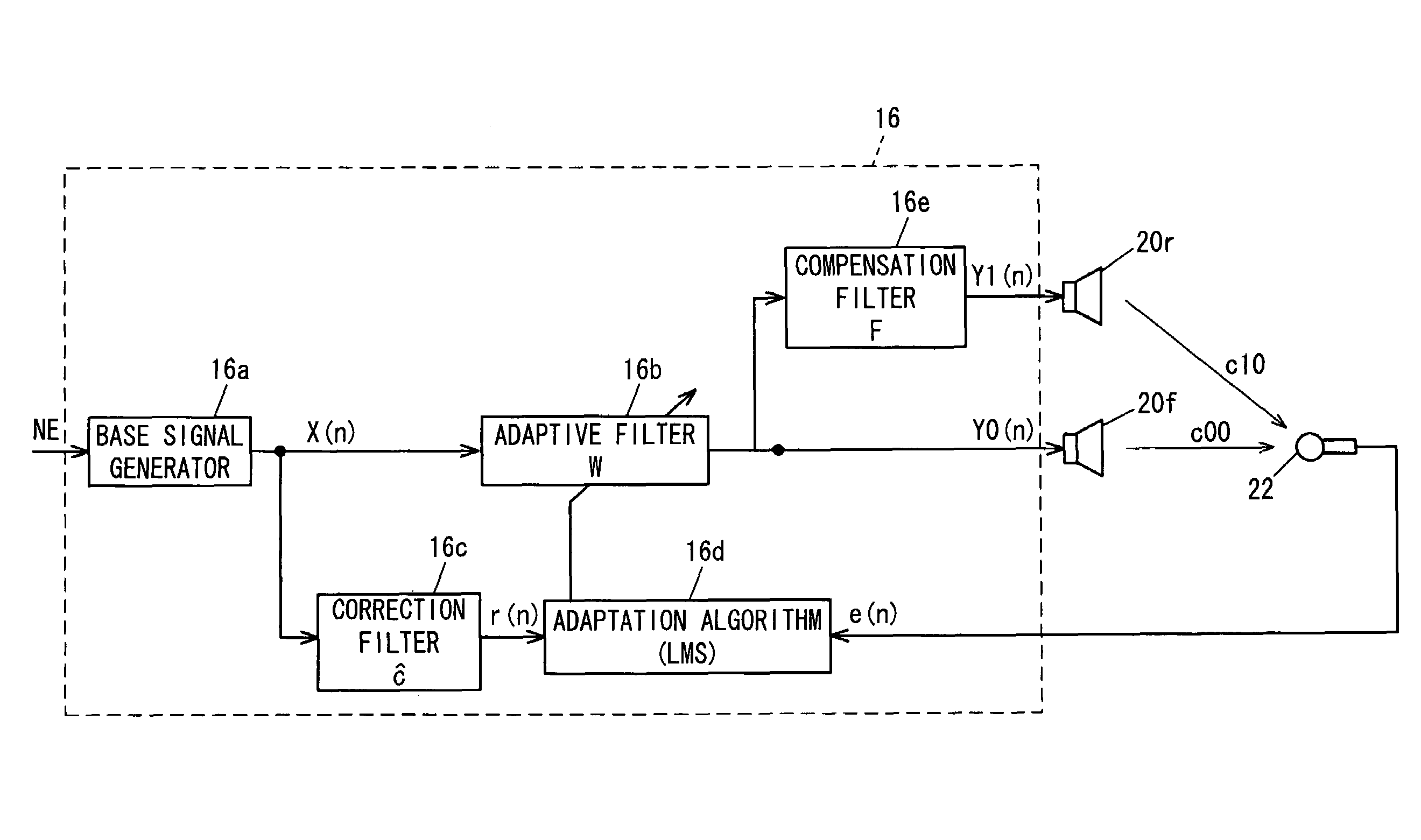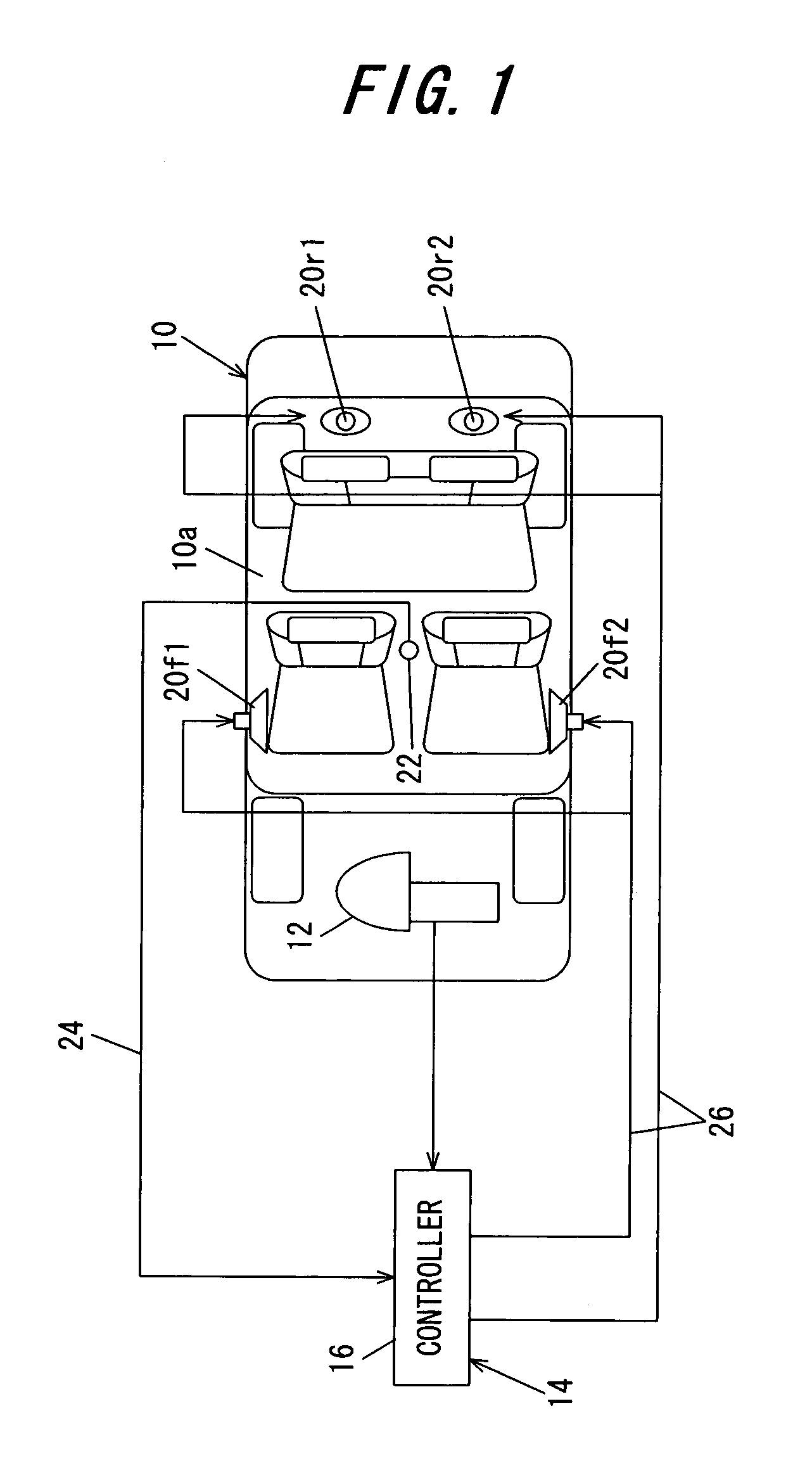Active noise cancellation system
a technology of active noise and filter, which is applied in the field of active noise cancellation system, can solve the problems of increasing the computational load involved in updating the filter coefficient of adaptive filters, and increasing the number of parts. , to achieve the effect of reducing noise, increasing the number of microphones, and increasing cos
- Summary
- Abstract
- Description
- Claims
- Application Information
AI Technical Summary
Benefits of technology
Problems solved by technology
Method used
Image
Examples
second embodiment
[0073]The active noise cancellation system according to the present invention will next be described.
[0074]A configuration is adopted in the active noise cancellation system according to the second embodiment whereby the filter coefficient (transfer characteristic) c of the correction filter 16c and the filter coefficient (characteristic; corresponds to prescribed value) F of the compensation filter 16e are prepared for each frequency and stored in the memory in advance so as to be retrieved by the frequency of the base signal X.
[0075]Describing this configuration, in the prior art ('344), control is performed to reduce noise according to the same adaptive feedforward control algorithm using an adaptive digital filter as described with reference to FIG. 3 such that the error signal detected by the microphone is minimized.
[0076]In the prior art, since sound or vibration is considered in a time domain in addition to the problem of the number of microphones, a high-performance, high-co...
third embodiment
[0099]The active noise cancellation system according to the present invention will next be described.
[0100]The technique for designing the system according to the third embodiment, more specifically, the filter coefficient F of the compensation filter 16e of the system, will be described with reference to FIGS. 6 and 16, which show the speaker-to-microphone transfer characteristic mentioned above.
[0101]Focusing on the aspects that differ from the first embodiment, in the third embodiment, the distribution of the booming noise at the front and rear seats is utilized in designing the filter coefficient F. The design technique for the filter coefficient F in the first embodiment is limited to being able to control the increased sound generated at the rear seats when reducing the booming noise of the front seats. However, the technique of the third embodiment allows the booming noise at the front and rear seats to be reduced.
[0102]In the description given hereinafter, the error signal e...
fourth embodiment
[0109]The active noise cancellation system according to the present invention will next be described.
[0110]FIG. 13 is a block diagram similar to FIG. 4, but showing the configuration of the active noise cancellation system according to the fourth embodiment.
[0111]In the fourth embodiment, a microphone 220 is temporarily placed at the rear seats when the compensation filter 16e is designed, the output ratio (speaker control signal ratio) Y1 / Y0 of the controller 16 at that time is calculated or measured by a controller output ratio calculator 30, and the filter coefficient (prescribed value) F of the compensation filter 16e is set on the basis of the output ratio thus measured. Then, the microphone 220 at the rear seats is removed after the characteristic of the compensation filter 16e is determined and the system is completed.
[0112]Thus, in the active noise cancellation system according to the fourth embodiment, the microphone 220 is temporarily placed at the pseudo or simulated eval...
PUM
 Login to View More
Login to View More Abstract
Description
Claims
Application Information
 Login to View More
Login to View More - R&D
- Intellectual Property
- Life Sciences
- Materials
- Tech Scout
- Unparalleled Data Quality
- Higher Quality Content
- 60% Fewer Hallucinations
Browse by: Latest US Patents, China's latest patents, Technical Efficacy Thesaurus, Application Domain, Technology Topic, Popular Technical Reports.
© 2025 PatSnap. All rights reserved.Legal|Privacy policy|Modern Slavery Act Transparency Statement|Sitemap|About US| Contact US: help@patsnap.com



